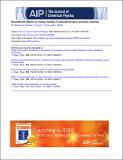| dc.contributor.author | Shabani, A. | |
| dc.contributor.author | Omar, Yasser | |
| dc.contributor.author | Rabitz, H. | |
| dc.contributor.author | Mohseni, Masoud | |
| dc.contributor.author | Lloyd, Seth | |
| dc.date.accessioned | 2015-07-01T14:33:03Z | |
| dc.date.available | 2015-07-01T14:33:03Z | |
| dc.date.issued | 2013-05 | |
| dc.date.submitted | 2012-12 | |
| dc.identifier.issn | 00219606 | |
| dc.identifier.issn | 1089-7690 | |
| dc.identifier.uri | http://hdl.handle.net/1721.1/97597 | |
| dc.description.abstract | We explore various design principles for efficient excitation energy transport in complex quantum systems. We investigate energy transfer efficiency in randomly disordered geometries consisting of up to 20 chromophores to explore spatial and spectral properties of small natural/artificial Light-Harvesting Complexes (LHC). We find significant statistical correlations among highly efficient random structures with respect to ground state properties, excitonic energy gaps, multichromophoric spatial connectivity, and path strengths. These correlations can even exist beyond the optimal regime of environment-assisted quantum transport. For random configurations embedded in spatial dimensions of 30 Å or 50 Å, we observe that the transport efficiency saturates to its maximum value if the systems contain around 7 or 14 chromophores, respectively. Remarkably, these optimum values coincide with the number of chlorophylls in the Fenna-Matthews-Olson protein complex and LHC II monomers, respectively, suggesting a potential natural optimization with respect to chromophoric density. | en_US |
| dc.description.sponsorship | United States. Defense Advanced Research Projects Agency. QuBE Program | en_US |
| dc.description.sponsorship | National Science Foundation (U.S.) | en_US |
| dc.description.sponsorship | Institute for Scientific Interchange | en_US |
| dc.description.sponsorship | NEC Corporation | en_US |
| dc.description.sponsorship | Lockheed Martin | en_US |
| dc.description.sponsorship | Intel Corporation | en_US |
| dc.description.sponsorship | Project IT-PQuantum | en_US |
| dc.description.sponsorship | Portuguese Science and Technology Foundation (Programme POCTI/POCI/PTDC) | en_US |
| dc.description.sponsorship | Portuguese Science and Technology Foundation (Project SFRH/BPD/71897/2010) | en_US |
| dc.description.sponsorship | Portuguese Science and Technology Foundation (Project PEst-OE/EEI/LA0008/2013) | en_US |
| dc.description.sponsorship | Portuguese Science and Technology Foundation (Project PTDC/EEA-TEL/103402/2008 QuantPrivTel) | en_US |
| dc.description.sponsorship | Seventh Framework Programme (European Commission) (Grant Agreement 318287) | en_US |
| dc.language.iso | en_US | |
| dc.publisher | American Institute of Physics (AIP) | en_US |
| dc.relation.isversionof | http://dx.doi.org/10.1063/1.4807084 | en_US |
| dc.rights | Creative Commons Attribution 3.0 Unported Licence | en_US |
| dc.rights.uri | http://creativecommons.org/licenses/by/3.0/ | en_US |
| dc.source | AIP | en_US |
| dc.title | Geometrical effects on energy transfer in disordered open quantum systems | en_US |
| dc.type | Article | en_US |
| dc.identifier.citation | Mohseni, M., A. Shabani, S. Lloyd, Y. Omar, and H. Rabitz. “Geometrical Effects on Energy Transfer in Disordered Open Quantum Systems.” The Journal of Chemical Physics 138, no. 20 (2013): 204309. | en_US |
| dc.contributor.department | Massachusetts Institute of Technology. Department of Mechanical Engineering | en_US |
| dc.contributor.department | Massachusetts Institute of Technology. Research Laboratory of Electronics | en_US |
| dc.contributor.mitauthor | Mohseni, Masoud | en_US |
| dc.contributor.mitauthor | Lloyd, Seth | en_US |
| dc.relation.journal | The Journal of Chemical Physics | en_US |
| dc.eprint.version | Final published version | en_US |
| dc.type.uri | http://purl.org/eprint/type/JournalArticle | en_US |
| eprint.status | http://purl.org/eprint/status/PeerReviewed | en_US |
| dspace.orderedauthors | Mohseni, M.; Shabani, A.; Lloyd, S.; Omar, Y.; Rabitz, H. | en_US |
| mit.license | PUBLISHER_CC | en_US |
| mit.metadata.status | Complete | |
